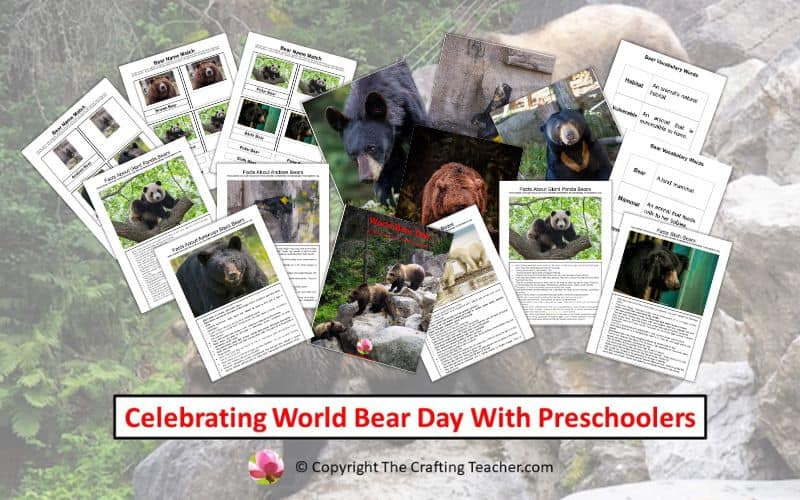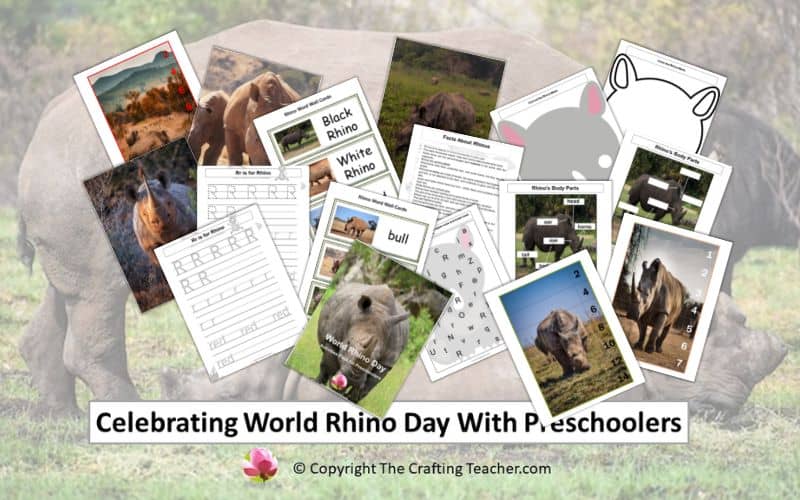Celebrating World Bear Day with Preschoolers
Every year on March 23rd, World Bear Day is celebrated around the world to raise awareness of the dangers they are facing, and advocate for the protection of these magnificent creatures and the preservation of their habitats, to maintain the balance of the ecosystems in which they play an important role, using educational activities and fundraising events.
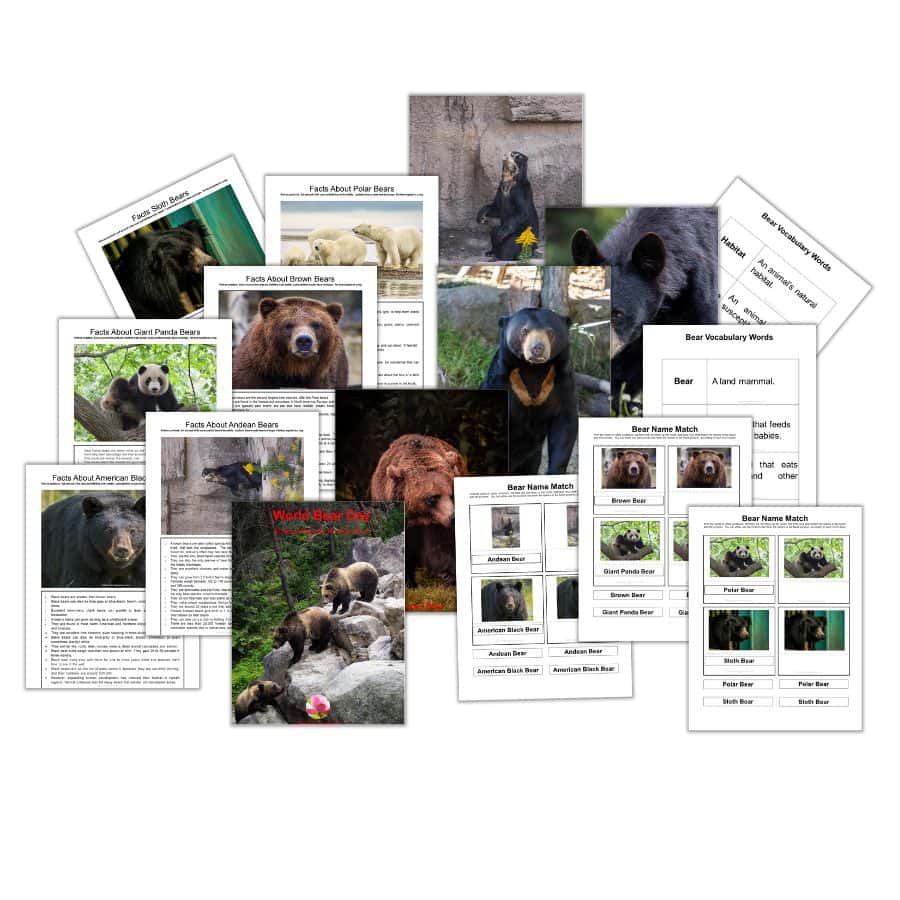
You can find a FREE 25-page long World Bear Day Science pack, which includes facts and real pictures of the 8 species of bears, vocabulary words, and name match activities, ready to be downloaded at the end of this post.
History of World Bear Day
World Bear Day was first established in 1992 as a small initiative by conservationists who wanted people to know all the species of bears and encourage them to protect these magnificent animals.
Since then, it has grown to global proportions and is celebrated all around the world not only to protect the bears that exist in every continent except for Australia and Antarctica but also to support the efforts that several organizations are doing to protect the bears and their habitats like the World Animal Protection International, the World Wildlife Fund, and the International Association for Bear Research and Management.
Importance of Bears
Like any other wildlife, bears are important to keep our ecosystem clean and healthy. There are many essential activities bears do as an important link of the food chain in their habitat. Some of those activities are:
- They dig up insects and by doing so, they mix nutrients in the soil, fertilizing it.
- They eat animal carcasses avoiding contamination.
- When they eat fruits, they spread the seeds which produce more plants to be born.
- They also prey on other animals controlling the population of those species and ensuring a greater biodiversity.
- They also serve as symbols of strength, wisdom, and resilience in many cultures, such as Native American tribes.
- They also attract ecotourism, which brings millions of dollars in revenue every year.
General Facts About Bears
- Bears are solitary mammals.
- They have thick, layered coats, which come in different colors and color combinations, depending on the species.
- Each species of bear is very recognizable by their distinct characteristics, size, and markings.
- They are big, strong and fast.
- Bears have excellent senses of smell, sight, and hearing.
- They can walk short distances on their back legs.
- Bears are one of the most intelligent land animals in North America.
- There are eight species of bears which are: Andean, American Black, Brown, Giant Panda, Polar, Sloth, Sun, and Asiatic Black Bears.
- They are found across North and South America, Europe, the Arctic, and Asia.
- Some of the species hibernate in the winter, and others don’t.
- An adult male bear is called a boar, a female is called a sow, and a baby is called a cub.
- They don’t usually attack humans unless they feel threatened.
- They can live up to 25 years in the wild, and up to 50 years in captivity.
- Six species of bears are threatened or vulnerable on the IUCN Red List, due to climate change, wildlife trade, deforestation, poaching, and hunting.
Types of Bear Species
There are eight living bear species found on multiple continents around the globe and several sub-species. Here is an overview of each of the main species and the threats they face.
Andean Bears
- Andean bears are also called spectacled bears due to light rings they have around their eyes, that look like eyeglasses. The rest of their bodies are covered in black or dark brown fur, and very often they can have the light markings extended down their chests.
- They are the only short-faced species of bear left.
- They are also the only species of bear that lives in South America, in the cloud forest in the Andes Mountains.
- They are excellent climbers and make beds with branches up in the forest canopy to sleep.
- They can grow from 5.5 to 6.5 feet in length.
- Females weigh between 132 to 176 pounds. Males are bigger and weigh between 220 and 386 pounds.
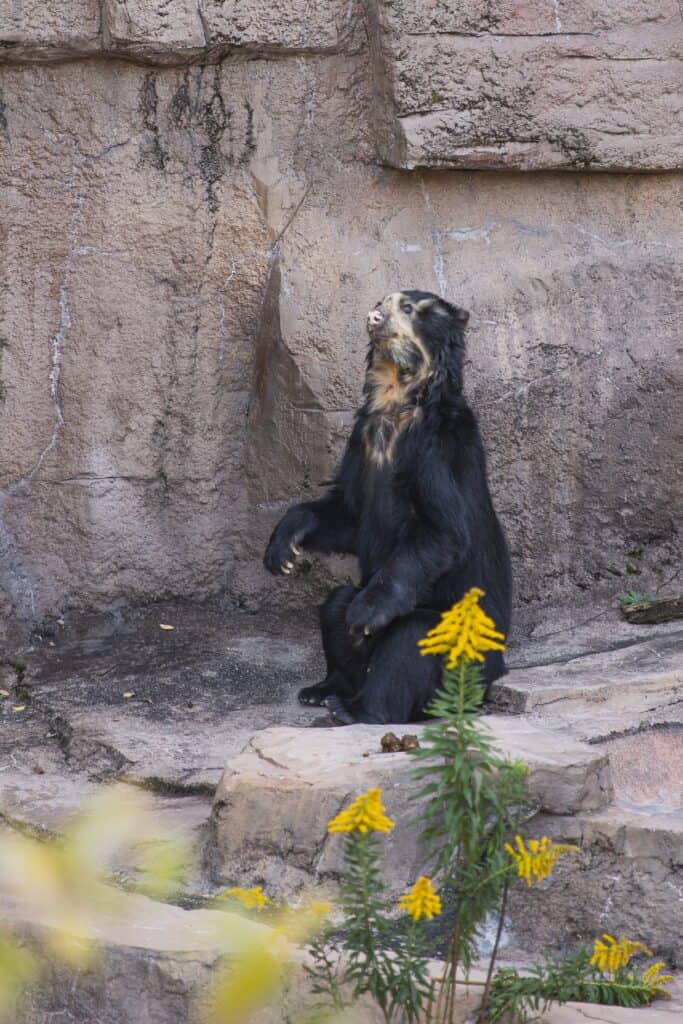
- They are omnivores and eat fruits, leaves, palms, rodents, snails, and insects. They are the only bear species to eat bromeliads.
- They do not hibernate and stay active all year round.
- They make unique vocalizations that go from a screech to a soft purring sound.
- They live around 20 years in the wild, and up to 38 years in captivity.
- Female Andean bears give birth to 1 to 4 cubs, and they are the only bears that carry their babies on their backs.
- They can also carry a club by holding it to their chest with one paw as they run or walk.
- There are less than 20,000 Andean bears left in the world and are considered a vulnerable species due to habitat loss, and being killed by humans.
American Black Bears
- American Black bears are smaller than brown bears.
- Besides being black, they can also be blue-gray or blue-black, brown, cinnamon, and very rarely, white.
- Excellent swimmers, black bears can paddle at least a mile and a half in freshwater.
- A bear’s claws can grow as long as a whiteboard eraser.
- They are found in most North American and Northern Mexico forests, mountains, and swamps.
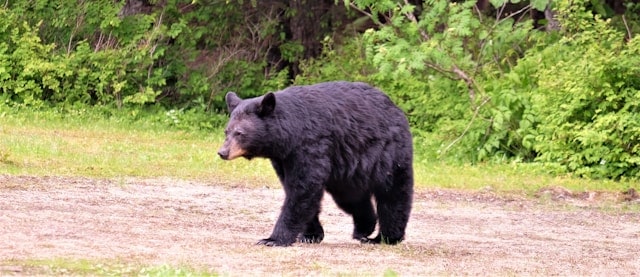
- They are excellent tree climbers, even sleeping in trees during the summer.
- Black bears can also be blue-gray or blue-black, brown, cinnamon, or even sometimes (rarely) white.
- They eat berries, roots, deer, moose, insects, dead animal carcasses, and salmon.
- Black bear cubs weigh less than one pound at birth. They gain 20 to 30 pounds in three months.
- Black bear cubs stay with Mom for one to three years while she teaches them how to live in the wild.
- Black bears are on the list of least concern, because they are currently thriving, and their numbers are around 500,000.
- However, expanding human development has reduced their habitat in certain regions. Vehicle collisions also kill many bears that wander into developed areas.
Brown Bears
- Brown bears are the second largest bear species, after the Polar bears.
- They are found in the forests and mountains in North America, Europe, and Asia.
- They are typically dark brown, but can also have reddish, cream, silver, yellowish, and almost black fur.
- They can grow more than 6 feet in length, and weigh up to 800 pounds, depending on age, sex, and season.
- They can run short distances at up to 50 kilometers per hour.
- They are excellent swimmers and can climb trees.
- Brown bears are generally solitary animals.
- They are omnivores who spend up to 16 hours a day looking for food. They eat berries, deer, grasses, salmon, squirrels, roots, moose, caribou, and even animal carcasses.
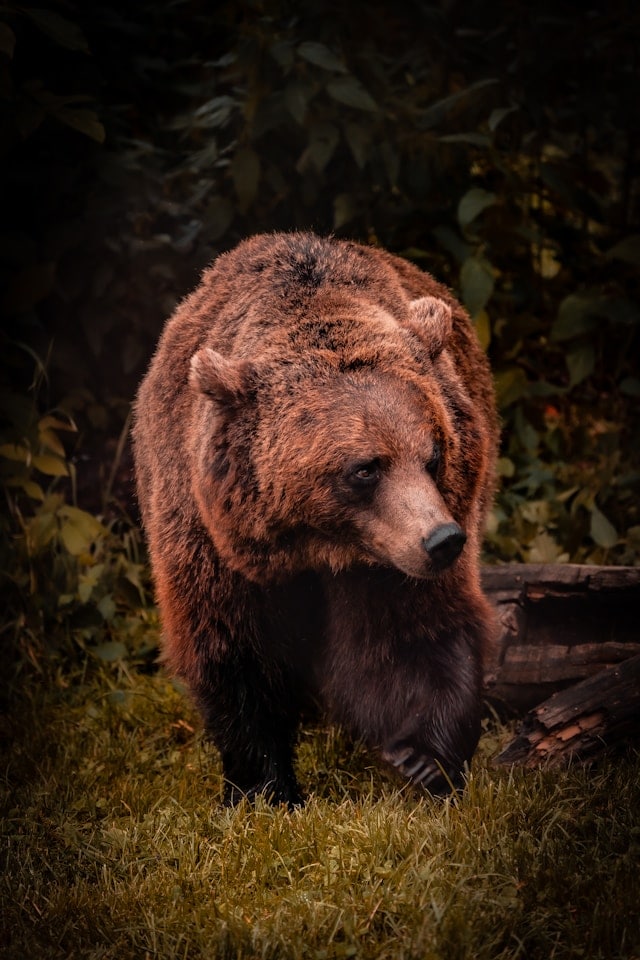
- These bears have a great sense of smell that enables them to sniff food at a distance of several kilometers.
- Brown bears in the wild are mainly active at dusk and night, and they hibernate during winter.
- At birth, bear cubs are blind and hairless.
- In the wild, brown bears can reach a maximum age of between 20 and 30 years. In captivity, they can get even older.
- American subspecies of brown bears are called Grizzly and Kodiak bears.
- There are around 180,000 to 200,000 brown bears worldwide.
- They are still on the least concern list, even when they are being displaced from parts of their habitats due to human settlements, and being hunted illegally for their body parts.
Giant Panda Bears
- Giant Panda Bears are mainly white but are black on their arms, legs, and around their eyes, which help them camouflage with their surroundings.
- Their pupils are vertical, like domestic cats.
- They are excellent tree climbers and good swimmers.
- They are only found in thick bamboo forests, high up in the mountains of central China.
- Their paws are different from other bears because they have a thumb-like wrist bone that helps them hold their food.
- They are considered omnivores, even when for the most part they only eat two types of bamboo, but occasionally they also eat eggs, small animals, carrion, pumpkin, beans, wheat, and fish.
- They spend 12 hours a day eating bamboo to satisfy their hunger.
- Male Giant Pandas can grow between 4 to 6 feet long and weigh up to 250 pounds, but females are smaller.
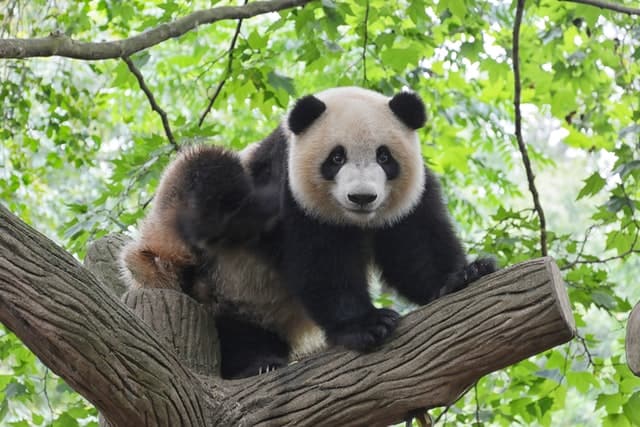
- They are mainly solitary, but sometimes they get together outside the breeding season.
- Giant Pandas communicate by marking their territory with scent and using calls.
- These bears don’t hibernate. During winter they go to warmer territories.
- Females give birth to one or two cubs every two years. Cubs are born blind, pink, and about the size of a pencil.
- During the first month, mothers protect their cubs by placing them on their chests or covering them with their paws, arms, or heads. Cubs also stay with their mother for 18 months after being born.
- This iconic bear was chosen by the World Wildlife Fund as its symbol.
- There are only 1,850 Giant Panda Bears left in the wild, and are considered a threatened species and very close to being considered endangered again due to habitat destruction and low-rate births, but China’s conservation efforts are helping Pandas increase their numbers.
Polar Bears
- Polar bears are the largest carnivores on land.
- Their skin is black, and their fur is transparent which reflects light, to help them blend with their surroundings.
- They have webbed feet that help them be excellent swimmers.
- They mostly eat seal blubber because of its high fat, caribou, grass, walrus, beached whales, seaweed, vegetation, geese, and bird eggs.
- Polar bears gallop to move around.
- Their nostrils close when they are swimming.
- Their short tails and ears prevent them from losing heat.
- Males usually weigh about 1,200 pounds, are over 8 feet long, and can stand 10 feet tall.
- Females are smaller and usually weigh about 330 to 650 pounds.
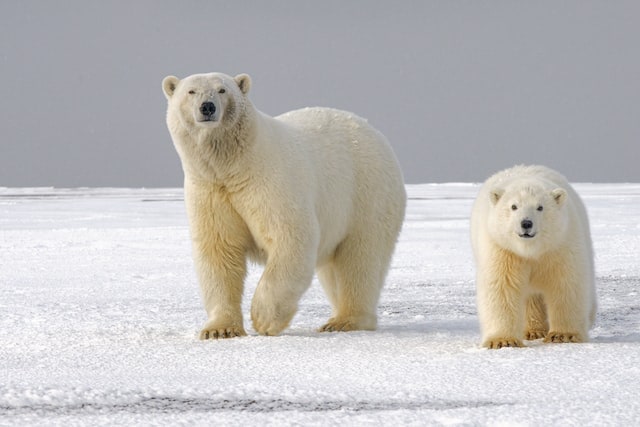
- Polar bears communicate through sight, touch, and smell.
- They clean their bodies by rolling around in the snow.
- Polar bears spend part of the year on land, they like to be alone, but sometimes they can be found in a group called a pack or a sleuth.
- Polar bears don’t hibernate.
- Mother bears build snow dens to birth up to two cubs, which are about the size of a stick of butter, and weigh the same as a guinea pig.
- The cubs stay with their mother for about two years to learn how to survive in the Arctic.
- Polar bears can live for about 25 to 30 years in the wild.
- They are considered vulnerable due to habitat caused by climate change, which is melting the ice.
Sloth Bears
- Sloth bears are named like that like because originally, they were mistaken for bear-liked sloths.
- They have shaggy, dusty-black coats, with a cream-colored “V” or “Y” shape on their chests, and have pale, short-haired long muzzles.
- They have a keen sense of smell, as well as near-sight similar to that of humans
- They eat fruits, flowers, ants, honey, ants, and termites, which they excavate with their long, curved claws. When the food is scarce, they eat crops and animal carcasses.
- Adult sloth bears don’t have top two front teeth, but they have large canines to defend themselves.
- They live in forests and some grasslands in India, southern Nepal, and Sri Lanka.
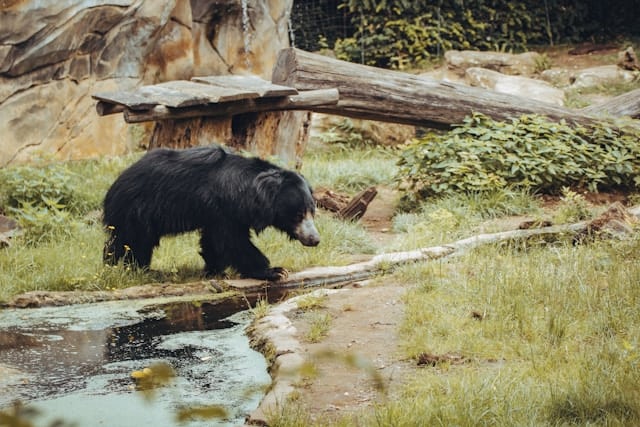
- Sloth bears grow up to 5 to 6 feet long, stand 2 to 3 feet tall, and weigh 200 to 300 pounds.
- Sloth bears make a lot of noise grunting and snorting as they look for food.
- They do not hibernate but sleep 10 to 16 hours a day, depending on how many bears, people, and other predators share their territory.
- They are solitary, but occasionally they might be seen in groups.
- They breed every three years and have a high infant mortality. When cubs survive, their mothers carry them on their backs until they are six to nine months old.
- They usually live 16 years in the wild and up to 40 years in captivity.
- They are considered a vulnerable species because there are only 10,000 to 20,000 left due to high cub mortality, habitat loss, poaching, and deadly encounters with humans.
Sun Bears
- The Sun Bear is the smallest bear species in existence.
- They live in rainforests in Southeast Asia.
- They are called Sun bears due to the golden patches of fur on their chests, resembling a rising sun.
- They have the shortest fur of all bear species, but it is thick enough to protect them against sharp branches.
- Their tongues are longer than the ones in other bear species, up to 10 inches long, and they use them to extract honey from beehives along with bees. They also eat leaves, lizards, earthworms, insects, and berries.
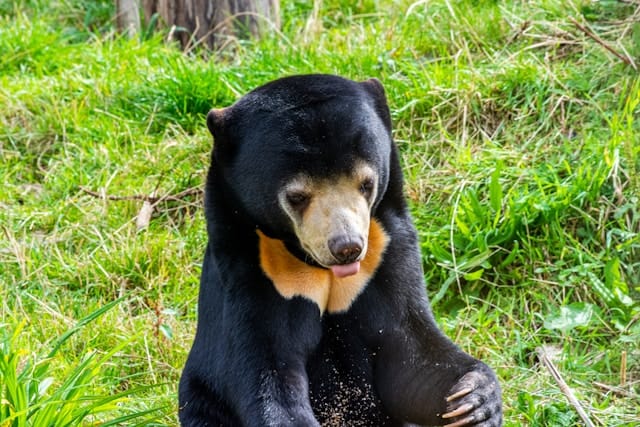
- They are strong agile climbers, spending most of their time in tree canopies, where they build beds of twigs and leaves.
- Males grow about 5 feet long and weigh up to 150 pounds.
- Females normally have 1 to 2 cubs at a time but can have more.
- Cubs weigh only half a pound when they are born, and stay with their mothers for 1 to 2 years. Sometimes mothers cradle their babies in their arms.
- They usually live 25 years in the wild.
- There are less than 10,000 individuals, for which this species is considered vulnerable, due to poaching for their gallbladders and other body parts, and habitat destruction due to deforestation for palm oil plantations.
Asiatic Black Bear
- Asiatic Black bears are called moon bears because they have a white, crescent moon-shaped patch on their chest, with a long black coat and a light-colored chin.
- They are omnivorous and feed on fruits, insects, nuts, small wild and domestic animals, crops, seeds, grasses, roots, bark, tubers, honey, acorns, mushrooms, insects, and animal carcasses.
- They are found in mountains, forests, and foothills with thick vegetation in Asian countries including China, Japan, and Korea.
- They have a heavy, strong body, and measure 4 to 6 feet in length.
- Males weigh 242 to 330 pounds, while females weigh 143 and 198 pounds.
- They have large, rounded heads, with small eyes, and large ears.
- Their paws are big and their tails are only two to four inches in length.
- They are good climbers and swimmers.
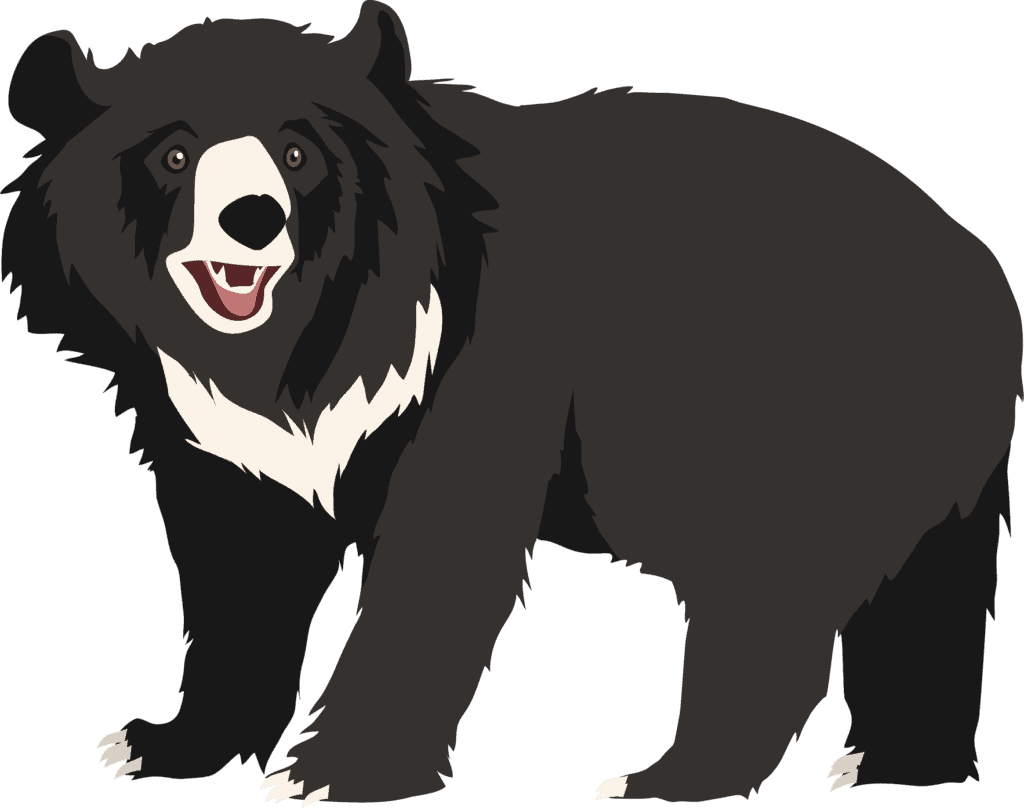
- These bears are solitary and nocturnal.
- They have a good sense of smell, excellent vision and hearing.
- When they fight, they stand on their hind legs and slap the other bear with their paws.
- Sometimes they might attack humans without provocation, but most of the time they do it only to protect their cubs, or when they are wounded.
- Not all Asiatic Black bears hibernate the entire winter. Some only sleep when the weather is most severe.
- Female Asiatic Black Bears have 1 or 2 cubs in a hollow tree or rock cavity.
- Cubs weigh 8 to 10.5 ounces at birth and stay with their mother until they are two to three years of age.
- There are less than 50,000 left and considered an endangered species, due to overhunting for their bile to be used in Asian medicine and habitat loss.
How to Celebrate World Bear Day
These are some ideas of activities you can do to celebrate World Bear Day with your preschoolers and support the efforts that organizations and individuals are making to protect these animals from extinction:
- Learn more about bears, and share it with your preschoolers, friends, and family members.
- In many places, zoos, conservation groups, and wildlife parks organize educational events and activities for children and adults, to educate them about the bear’s ecological importance, the threats they are facing, and how we can help. Find out which of these events are being offered locally, and invite your families and everybody you know to participate.
- Show support by organizing a fundraising to collect funds to be donated to an organization that works on behalf of the bears like the Grizzly Bear Foundation, the American Bear Association, the Great Bear Foundation, World Animal Protection International, the World Wildlife Fund, and the International Association for Bear Research and Management. These types of organizations use collected funds to continue their conservation programs.
- People learn better and get more motivated if they can see things with their own eyes, especially children, so watch and present bear documentaries, so they can see bears in the wild, and get to know them better. Below are some that I like.
- We know how powerful social media can be. Use yours to share your love for bears with the hashtags #WorldBearDay and #SavetheBears. This will allow conservation organizations to offer information and motivate people to take action to help bear populations across the globe, and tell people about the progress these organizations are accomplishing in certain regions, to offer hope and motivate people to keep on helping.
- Include in your lesson plans bear-themed crafts to do with your preschoolers. You can find a lot of different bear crafts you can do with your preschoolers at Twitchetts, ABCDee Learning, and Artsy Craftsy Mom.
- Offer your children bear-related food and snacks. You can find many ideas offered by Evan Michel Franco, Lisa Werner, and Amy Hood on Pinterest for your preschoolers, and many of these recipes can be prepared by the children as well.
- Participate in and promote a campaign to symbolically adopt a bear through the American Bear Organization, the National Wildlife Federation, the Appalachian Bear Rescue, the Sierra Club, the North Carolina Zoo Society, or the World Wildlife Fund (WWF). You can encourage your children, family, and friends to do the same using posters, signs, your social media, and any other type of activity you can think about. If you work at a school, you can even offer a friendly competition to see which classroom adopt more bears.
- Organize a field trip with your preschoolers and their families to visit a bear sanctuary, or a zoo in your area. That way you all can see bears firsthand, and learn about them.
- Write letters and participate in the written petitions that environmental organizations do on World Bear Day, to encourage politicians to create or modify laws to stop deforestation and the practices that many companies are causing climate change, and to support the efforts to stop the wildlife trade and abusive poaching affecting the bears.
Other Activities
- Race pretending to be born.
- Help your children measure the different bear sizes in the playground, using strings or steps.
- Play “Follow the Bear”, like you would “Follow the Leader”.
- Invite preschoolers to copy the names of the bears with pencils, markers, or crayons, or match them with magnetic, wooden, or foam letters.
- Have children spell the bear names.
- Have them count mini toy bears.
- Have them use counting bears to create patterns.
- Have them sort bears by color.
- Have them color a bear with crayons or markers, or paint it with tempera paint.
- Add water, mini bears, pebbles, moss, and small branches to the sensory table, for them to play with.
- Present pictures of bears and have them compare their characteristics.
- Have them find other words that have the same beginning sound.
- Have them find rhyming words.
- Have them clap the syllables of the bear names.
- Invite an expert to come to the classroom and talk to your children about frogs, and what we can do to help protect them.
Bear-related Books
Reading bear-related books to your children, both fictional and nonfictional, is one of the best educational activities you can do to teach your kiddos about these animals.
Below are some of my favorite books about bears. You can find them in your local library, used bookstore, and on Amazon. I added my Amazon links to make it easier for you if you want to add some to your collection, just by clicking on the titles.
- All Things Bears For Kids by Animal Reads. This colorful book is filled with amazing real-life images and aims to combine fun with education to help preschoolers learn all about bears.
- All About Bears by John Ross uses a rhyming style to teach children about the different habitats of bears and how they interact with their environment, the unique characteristics of each species of bear, the importance of conservation, and how to protect our wildlife for future generations.
- Goldilocks And The Three Bears by Parragon Books. This classic tale comes to life in this vibrant storybook, which is designed to encourage vocabulary development and help children read aloud, using large font types and vivid, contemporary illustrations.
- The Bear Ate Your Sandwich by Julia Sarcone-Roach. This book tells a story full of happy accidents, funny encounters, and sensory delights.
- Spring is Here: A Bear and a Mole Story by Will Hillenbrand. A perfect read-aloud, full of simple sound words and lots of repetition, with mixed-media illustrations of a big, fuzzy, dozing bear and his eager mole friend to add detail and humor to the tale.
- Brown Bear, Brown Bear, What Do You See? by Bill Martin Jr. Uses repetition, rhyme, and rhythm to help children identify farm animals and colors.
- Bear Snores On by Karma Wilson. This cute book tells of different animals and birds that find their way out of the cold and into Bear’s cave to warm up and have a party, while Bear sleeps.
- Polar Bear, Polar Bear, What Do You Hear? by Bill Martin Jr. and Eric Carle. Help children identify wild animals and the noises they make, using rhyme, rhythm, and repetition.
- Bears by Kay de Silva. This book gives children a well-rounded understanding of these beautiful animals: their anatomy, feeding habits, and behavior.
- Welcome to Bear Country by Mike Berenstain. The Berenstain Bears visit everything from Bear Town to museums, caves, and even Bear Country’s most prized highlight—the Old Honey Tree, in this story.
Pin It For Later
If you are in a rush and don’t have time to read the post and download the printable but want to save it for later, pin it to one of your Pinterest boards.

By inspiring people to care about bears, and be their voice starting with ourselves, we can make a big difference in preserving these magnificent animals as well as many other species that are vulnerable or endangered on our planet.
I hope you enjoy these ideas, and help you have fun during the World Bear Day celebration with your preschoolers. To get the FREE pack, you just have to click on the link below and type your information, for an immediate download.
Be happy, safe, and creative. I wish you well.
Love,

P.D. Please let me know if any of these ideas work for you, or if you think I need to add or replace something. My goal is to help you in any way I can.

